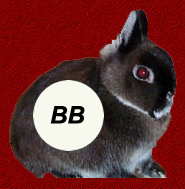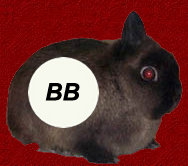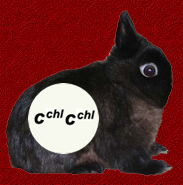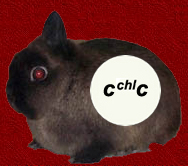Light
Chinchilla cchl


Moving one step lower on the
c-series ladder, we find light chinchilla cchl,
with no yellow pigment in the coat whatsoever and only two units of black
pigment with which to colour the fur shaft.
Since this is
the c-allele responsible for producing our
shaded varieties
of Netherland Dwarfs, you have
to mentally substitute 'shaded'
for 'light chinchilla' in order to understand
cchl's effect.
During the 1920's and 1930's a number of geneticists in Europe and the
U.S. were performing the bulk of the studies regarding coat colour in rabbits
that is used as reference material.
These geneticists were scientists, not rabbit fanciers and though
they were sensitive to subtle nuances of colour, they didn't follow the
standard descriptions of the verieties.
The geneticists, being pioneers in the field
of rabbit colour, often coined their own names for the colour genes.
Apparently, they studied the c-series alleles via
chinchilla-coloured rabbits,
and, when the 'shaded' gene appeared,
they saw the effect in terms of a lightened Chinchilla
and naturally named this gene allele 'light chinchilla cchl.
The agouti-patterned
light cchl
is not a recognised variety of Netherland Dwarf.
What
is described by the term "Sable
Agouti" is
the
"Ghost Chinchilla". Since the
agouti pattern A gene allele bands the
fur shaft, dividing the black and yellow pigment into distinct zones - the Sable
Agouti appears with an intermediary band coloured differently from the base and
tip. Since there is no yellow
pigment at all in the fur shaft, there is no underlying colour on any portion
of
the hair shaft,
this leaves the
intermediary band area unpigmented,
therefore, white.
There are two units of black pigment covering this white fur shaft at the
base and tip. However, with only two units of black covering this otherwise
'bare' hair shaft, the colour is weakened from the true black of the full colour
and dark chinchilla rabbits to a dark brown in the Sable Agouti.
The Sable Agouti resembles the Chinchilla in having a fur shaft that is
darkly-coloured at the base, light in the middle portion, and darkly-coloured at
the tip. It is easy to
confuse the Sable Agouti with the genuine Chinchilla and occasionally
Sable Agoutis are
exhibited at shows
but usually recognised as being "poor
in colour"
for a Chinchilla
as the fur tips of the Sable Agouti are,
after all, dark brown instead of the jet black of the agouti-patterned dark
chinchilla Chinchilla.
The
at
and
a light chinchilla
is the Marten Sable
and Siamese Sable respectively. Should
the Dwarf inherit a pair of light chinchilla cchlcchl
alleles, it will be a Dark Sable. Except for
the white belly and ticking, the tan
pattern Marten Sable is essentially the same colour as the
self-patterned Siamese Sable. With
sables,
the
hair shaft is void of the underlying yellow pigment, but is covered root to
tip, by two units of black pigment. The
two units of black can only achieve a brown colour as compared to the black
produced by the four units of black pigment present in the full colour C and dark chinchilla cchd
alleles. We also observe the effect
the light chinchilla cchl
allele has in producing darker colour where
the fur is shorter and the pigment more concentrated in the extremities (head, ears, legs and
feet, and tail).
To produce a medium
sable, the light chinchilla
gene allele must be inherited along with one of the lower c-alleles.
The effect of this genotype results in lightening the overall colour of
the dark sable
to the medium shade sable.
It is a peculiarity of the c-series that while some of the gene alleles
have a fully dominant-recessive relationship with one another, other alleles are
only incompletely dominant or
recessive. Breeding dark
and medium sables is a good example of seeing how light chinchilla
cchl
is visibly affected by the presence of
himalayan
ch or albino c, with both expressing their presence in the phenotype to produce a
medium
sable. If
cchl
were
completely dominant over its lower c-alleles, we would not see this
lightening effect of the lower allele and there would be no discernible
difference between a cchldark
sable and a cchlch or
cchlc
medium
sable. When gene alleles
have an incompletely
dominant-recessive relationship, evidence of both the dominant
and the recessive
alleles are expressed in the phenotype.
Here again, in order to produce a correctly-coloured
Siamese Sable, the light chinchilla cchl
allele must be inherited along with either himilayan ch or albino c to lighten
the Seal to the desirable medium Siamese Sable.


dark
siamese sable medium
siamese sable
Full
Colour C
Dark
Chinchilla cchd
Himalayan
ch
Albino c
back
to colour distribution
in the fur shaft
the
basic patterns
the
basic colours
extension
of colour in the fur shaft
back
to hompage



